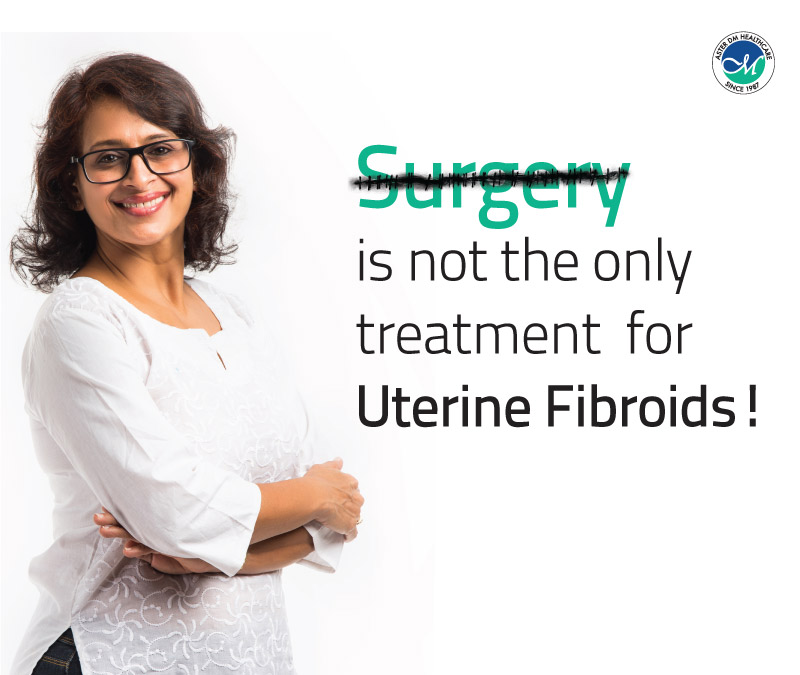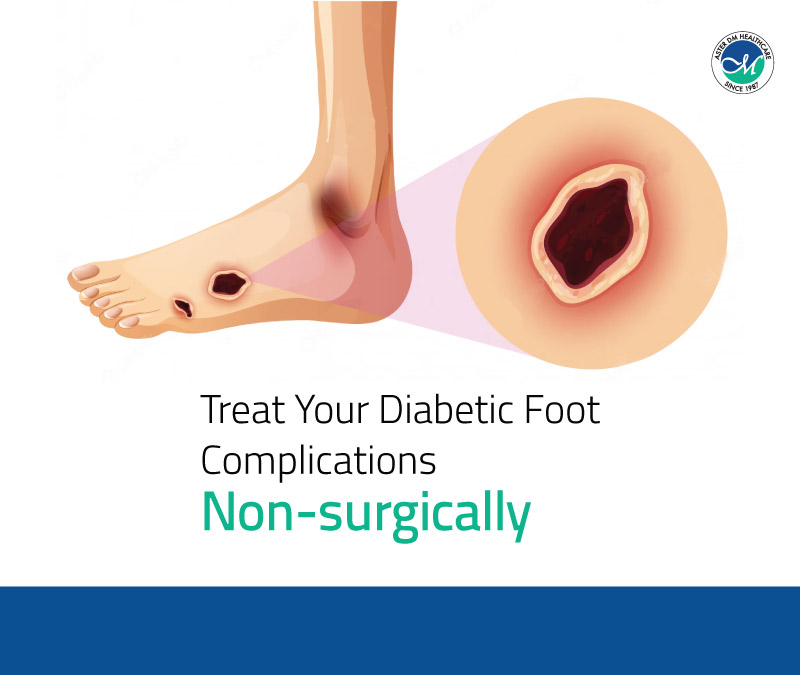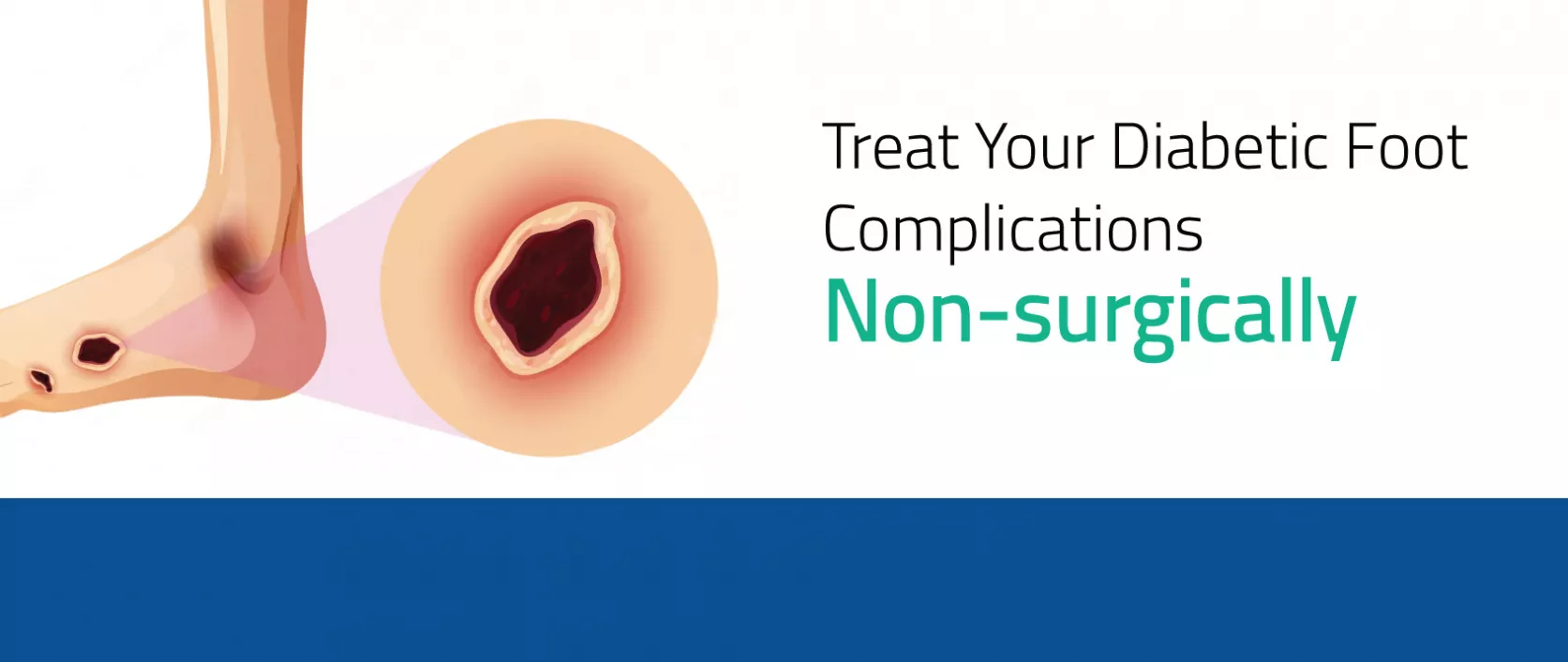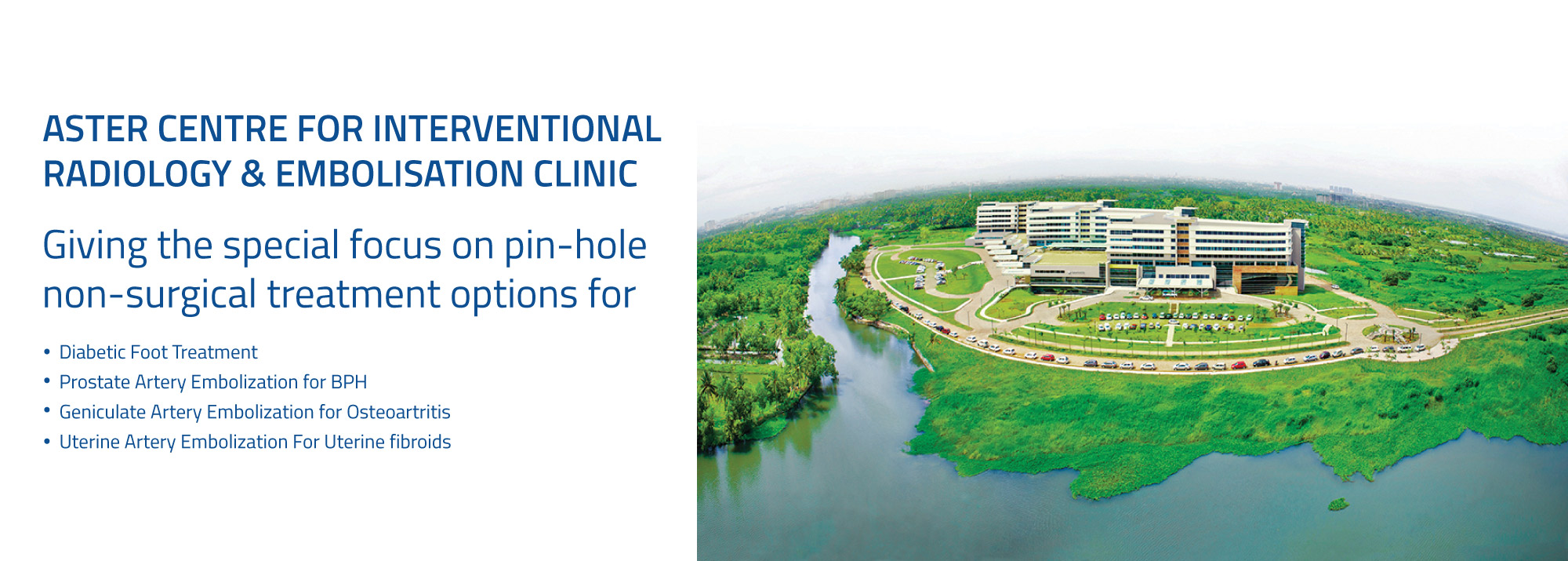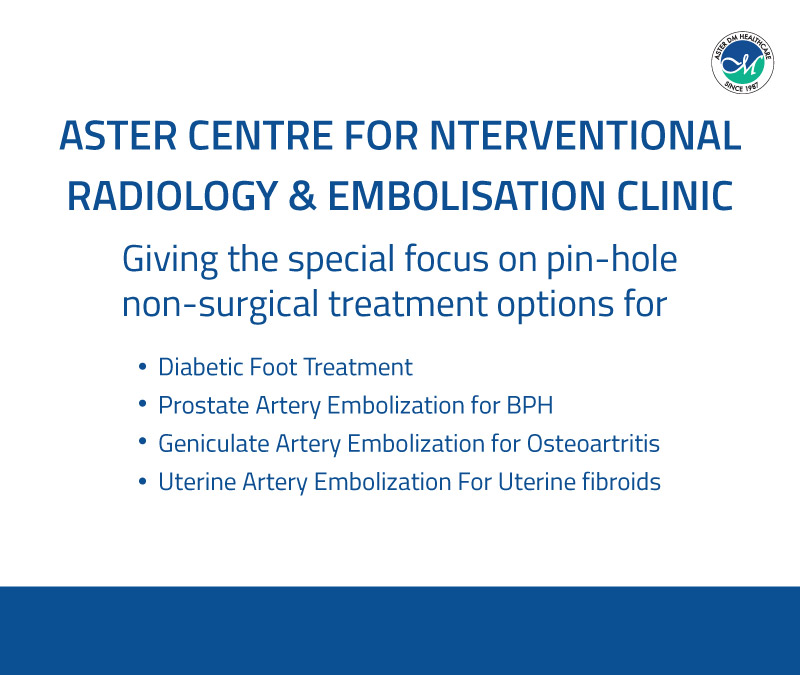INTERVENTIONAL RADIOLOGY & EMBOLIZATION CLINIC
The Interventional Radiology & Embolisation Clinic at Aster Medcity is conceptualized with a special focus on pin-hole non-surgical treatment options for a gamut of health conditions such as Fibroids, Enlarged Prostate, Knee Osteoarthritis, Liver Tumor, Obesity, Aneurysm, and Stroke. Helmed by the qualified Interventional Radiologist, the clinic shall offer expert advice to people who can be treated with non-surgical short-stay treatment options for their health conditions.
ARTERIAL EMBOLISATION
Arterial Embolisation is a pinhole minimally invasive or non-surgical procedure.
Over the past few decades, advances in arterial embolisation have transformed the procedure into a safer, more effective one with a quick recovery - most patients are fully recovered within two weeks.
The procedure is carried out in a Cath Lab by an interventional radiologist.
It involves in blocking of blood supply through a blood vessel to an abnormal area of tissue.
During the procedure, a small incision is made in the inner thigh and a thin flexible tube (catheter) is inserted and guided into an artery near abnormal tissue.
Once the catheter is in place, micron sized particles are injected which blocks the artery and stops the flow of blood to the tumor or abnormal area of tissue.
Arterial Embolisation or Trans-arterial embolisation (TAE) is used to treat Fibroids, Enlarged Prostate, Knee Osteoarthritis, Liver Tumor, Chronic Pelvic Pain (Pelvic Congestion Syndrome), Weight Loss, and even some types of kidney cancer, and neuroendocrine tumors.
At Aster Medcity, we always strive to deliver complete, comprehensive and compassionate care at one-place. All the treatment options are made available to them. The best possible treatment plan is derived keeping the patient's conditions in mind.
Non-Surgical treatment for the patients with Uterine Fibroids.
UFE is an effective alternative to surgery for many women with uterine fibroids and has a lower risk of complications and shorter recovery time compared to surgical options such as hysterectomy or myomectomy. However, UFE may not be suitable for all women, and it's important to discuss the potential risks and benefits with a healthcare provider.
Fibroids are benign tumours of the uterus, mostly seen in women during their reproductive age. More than 50% of the patients with uterine fibroid remain asymptomatic, hence needing no treatment at all. However, in many women, these may cause heavy menstrual bleeding, prolonged periods, anaemia, dysmenorrhea (painful periods), intermenstrual bleeding and infertility requiring medical attention. Large fibroids can also cause bloating, pelvic pressure, increased urine frequency and bowel disturbance.
Uterine fibroid embolization (UFE) is a minimally invasive procedure used to treat fibroid tumors of the uterus which can cause heavy menstrual bleeding, pain, and pressure on the bladder or bowel. It uses a form of real-time x-ray called fluoroscopy to guide the delivery of embolic agents to the uterus and fibroids.
These agents block the arteries that provide blood to the fibroids and cause them to shrink. Studies have shown that nearly 90 percent of women who undergo UFE experience significant or complete resolution of their fibroid-related symptoms.
New treatment for uterine fibroids with excess bleeding or abdominal/back pain
Advantages compared with surgery – No scar / sutures
No anesthesia
Only one day hospitalization
Early resumption of activities within 3 days
10 times safer than surgery
Patient can walk out of procedure room.
Very less pain & No rest needed
Uterine fibroid embolization (UFE) is typically recommended for women who have symptomatic fibroids that are causing significant pain, heavy bleeding, or other issues. Symptoms of fibroids can vary, but some common ones include:
Heavy or prolonged menstrual periods
Pelvic pain or pressure
Difficulty emptying the bladder or bowel
Back or leg pain
Painful sexual intercourse
UFE may be recommended as an alternative to surgery, particularly for women who want to preserve their uterus and fertility. UFE has been shown to be effective in shrinking fibroids and reducing symptoms in many women. It also has a lower risk of complications and shorter recovery time compared to surgical options such as hysterectomy or myomectomy.
However, UFE may not be suitable for all women. For example, women who are pregnant or planning to become pregnant soon may not be good candidates for the procedure. It's important to discuss the potential risks and benefits of UFE with a healthcare provider to determine if it's the right option for you.
Uterine fibroid embolization (UFE) is a minimally invasive alternative to conventional treatments for uterine fibroids, such as hysterectomy or myomectomy. Hysterectomy is a surgical procedure that involves removing the entire uterus, while myomectomy involves removing only the fibroids. Both procedures require general anaesthesia and a hospital stay, and recovery time can be several weeks.
In contrast, UFE is a minimally invasive procedure that can be performed on an outpatient basis. The procedure involves blocking the blood supply to the fibroids, causing them to shrink and die over time. This is accomplished by injecting small particles into the arteries that supply blood to the fibroids, using X-ray guidance.
Compared to conventional treatments, UFE has several advantages:
It is less invasive and does not require general anesthesia.
Recovery time is typically shorter.
There is a lower risk of complications, such as infection or blood loss.
The uterus is preserved, which is important for women who want to maintain their fertility.
After a uterine fibroid embolization (UFE) procedure, most women experience relief from the symptoms caused by their fibroids, such as heavy bleeding, pelvic pain or pressure, and frequent urination. In general, women can expect to resume their normal activities within two weeks after the procedure, although recovery time may vary depending on individual circumstances.
Some women may experience mild to moderate pain or cramping for a few days after the procedure and may be prescribed pain medications to manage this. It's important to avoid strenuous activity for several days after the procedure, and to avoid lifting heavy objects for a week or two. Most women can return to work within a few days to a week, depending on the type of work they do.
In the months following UFE, the fibroids will gradually shrink and die, and symptoms should continue to improve. In general, UFE is a safe and effective treatment option for many women with uterine fibroids, and can lead to significant improvements in quality of life.
Non-Surgical treatment for the patients with benign prostate hyperplasia (BPH).
Prostatic artery embolization is a minimally invasive medical procedure to treat symptomatically enlarged prostate or benign prostatic hyperplasia - a condition that causes the prostate gland to enlarge and obstruct the urethra. Symptomatically enlarged prostate leads to difficulty in urinating, urinary urgency, and frequent urination
Prostate enlargement, also known as benign prostatic hyperplasia (BPH), is a common condition in older men that causes symptoms such as poor urinary flow, frequent urination during the day and night, incomplete bladder emptying, and sudden urge to urinate.
More than 50% of old age males in rural India suffer from this problems. Prostate Artery Embolization or PAE is a procedure technique that shrinks the prostate by treating its blood vessels.
No scar / Sutures
No Anesthesia
Day care procedure
No hospital admission required
No sexual dysfunction
Very less use of urinary catheter
Very less bleeding
Faster recovery time without hospitalization
Lower risk of complications
Prostatic artery embolisation (PAE) is one of the latest options to help treat moderate to severe cases of benign prostate hyperplasia (BPH) and helps improve lower urinary tract symptoms caused by enlarged prostate. BPH is a noncancerous enlargement of the prostate gland and is the most common benign tumor found in men.
Prostatic artery embolisation is a minimally invasive, catheter-based procedure that shrinks the prostate by blocking blood flow to the gland. As with cardiac catheterization, radiologists enter through either the radial artery in the wrist or the common femoral artery in the hip. With a small wire and catheter, they navigate the blood vessels in the pelvis to reach the prostate.
The prostate gland has two arteries, a right and a left. The interventional radiologists use the one puncture and just reposition the catheter to reach each artery and embolize, or close if off. Micron sized tiny particles are injected into the prostate arteries until blood flow significantly diminishes.
Prostatic artery embolization (PAE) is recommended as a treatment option for men with benign prostatic hyperplasia (BPH) who have moderate to severe symptoms that are not effectively managed with medication. BPH is a common condition that causes the prostate gland to enlarge and obstruct the urethra, leading to symptoms such as difficulty urinating, urinary urgency, and frequent urination.
PAE is recommended when medication and other non-invasive treatments have failed to improve symptoms or when surgery is not an option due to the patient's medical history or preference. PAE is a minimally invasive alternative to traditional surgical treatments for BPH, such as transurethral resection of the prostate (TURP) and Holmium Laser Enucleation of Prostate (HoLEP), which involves removing part of the prostate gland.
PAE is a safe and effective procedure that can provide long-lasting relief of BPH symptoms. It has been shown to improve urinary symptoms, quality of life, and sexual function in men with BPH, with a shorter recovery time compared to surgery.
Prostatic artery embolization (PAE) is a minimally invasive treatment for BPH that is different from conventional treatments such as TURP, HoLEP, and open prostatectomy.
Here are some of the key differences between PAE and conventional treatments:
Minimally Invasive: PAE is a minimally invasive procedure that does not require any incisions in the body. In contrast, conventional treatments such as TURP and open prostatectomy involve making incisions in the body to remove part of the prostate gland.
Anesthesia: PAE can be performed under local anesthesia or conscious sedation, while conventional treatments usually require general anesthesia.
Daycare procedure and quicker recovery: PAE is typically performed as an outpatient procedure, which means that patients can go home the same day. In contrast, conventional treatments usually require an overnight hospital stay and a longer recovery time.
No risk of bleeding: PAE does not carry the risk of bleeding or infection that is associated with surgical incisions.
Sexual function: PAE is less likely to cause sexual side effects compared to conventional treatments. In fact, PAE has been shown to improve sexual function in some men with BPH.
Overall, PAE is a safe and effective alternative to conventional treatments for BPH. It can provide long-lasting relief of BPH symptoms with minimal risk of complications and a shorter recovery time.
For many men, life after prostatic artery embolization (PAE) is improved, with relief of symptoms and improved quality of life. PAE is a minimally invasive procedure for benign prostatic hyperplasia (BPH) that has been shown to be effective in improving urinary symptoms, sexual function, and quality of life
Non-Surgical treatment for the patients with osteoarthritis (OA)
We often think of osteoarthritis as a wear-and-tear disease that degrades cartilage and leads to bone-on-bone grinding. That is what we have always conventionally thought of as the cause of the pain. But newer data suggest that in addition to that, the pain source is probably inflammation. The inflammation likely contributes to the degeneration of the joint. The idea behind this minimally invasive procedure is that decreasing the blood supply to damaged areas of the knee joint will reduce inflammation and thereby decrease pain.
No scar / Sutures
No Anesthesia
Day care procedure
No hospital admission required
Faster recovery time without hospitalization
Lower risk of complications
Genicular artery embolisation (GAE), or embolisation of the knee, is the latest pin-hole non-surgical procedure providing immediate and long-term pain relief for patients with osteoarthritis (OA).
Genicular artery embolisation is a proven treatment option that reduces pain and other symptoms, like stiffness and problems with gait, in more than 70% of patients. These patients had tried other treatments, like injections, without success and either were not candidates for knee replacement surgery or had decided against having it.
The procedure is performed by interventional radiologists – doctors specially trained to do minimally invasive vascular procedures, such as angioplasty and embolization, to treat a variety of conditions.
Non Surgical Treatment for the patients with Diabetic Foot Problem
A diabetic foot ulcer is an open sore or wound that occurs in approximately 15 percent of patients with diabetes, and is commonly located on the bottom of the foot. Of those who develop a foot ulcer, six percent will be hospitalized due to infection or other ulcer-related complication.
Non-Surgical Treatment
No Anesthesia
Day care procedure
No hospital admission required
Faster recovery time without hospitalization
Lower risk of complications
A Diabetic Foot is any pathology that results directly from peripheral arterial disease (PAD) or sensory neuropathy affecting the feet in diabetes mellitus. It is a long-term complication of diabetes mellitus.
Diabetic foot treatment consists of Debridement, in which there is the removal of all necrotic tissue, peri-wound callus, and foreign bodies, Offloading, and Infection control. Arterial Embolisation is a pinhole minimally invasive or non-surgical procedure for Diabetic Foot Problems
WHY ASTER MEDCITY
We'll Treat You Well - This promise sums up why we exist. This promise is what we strive to honour every day, every moment.
We Believe In The Aster Experience - This is what helps us deliver our promise. This is what sets Aster apart. This is what makes you journey through any Aster environment smooth, efficient, and productive.
We Believe in Designing Hospitals That Heal Faster - Our hospitals are designed based on inputs and insights from patients by specialised architects with the clear intention of creating a soothing, spacious, uncluttered, warm, caring ambience that puts our patients instantly at ease.
FACILITIES
Shorter hospital stay (1-2 days)
Quicker recovery
Preservation of Uterus
Very minimal pain
Stich less or pin hole procedure
Here are the list of best Interventional Radiologist & Embolisation doctor at Aster Medcity Kochi that offers full fledge comprehensive treatment for Interventional Radiologist & Embolisation problems using advance equipments & modern approach



Experts Advice
Arterial Embolisation is a pinhole minimally invasive or non-surgical procedure. The procedure is carried out in a Cath Lab by an interventional radiologist. It involves in blocking of blood supply through a blood vessel to an abnormal area of tissue.
Being a pinhole non-surgical procedure, it is usually performed as a day-care or short-stay procedure. Since there are no incisions, there are very minimal pain and no blood loss. The recovery also is very quick.
It is a well-established, safe, and effective non-surgical procedure in the management of symptomatic uterine fibroids, to reduce knee pain for patients with osteoarthritis, to reduce the lower urinary tract symptoms caused by enlarged prostate, and few types of tumors.
Arterial Embolisation or Trans-arterial embolization (TAE) is used to treat Fibroids, Enlarged Prostate, Knee Osteoarthritis, Liver Tumor, Chronic Pelvic Pain (Pelvic Congestion Syndrome), Weight Loss, and even some types of kidney cancer, and neuroendocrine tumors.
The procedure generally takes between 30 and 120 minutes, and the patient can go home the same day.


